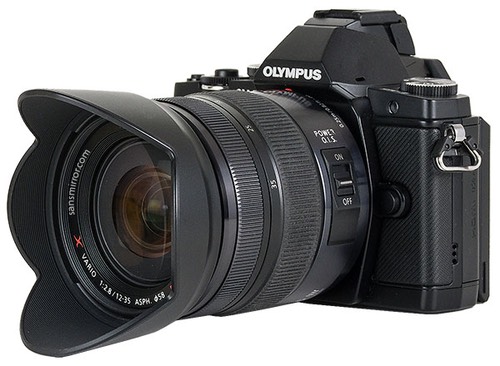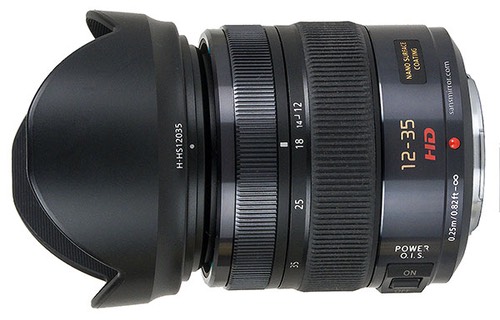
What is It?
Note: this review is of the first version of this lens. There is a slightly updated II version of this lens available now.
The 12-35mm f/2.8 from Panasonic is the m4/3 equivalent of the 24-70mm f/2.8 lens for 35mm and full frame digital cameras. In other words, a pro bag staple.
The actual lens design is reasonably complex, with 14 elements in 9 groups. Much of the optical complexity comes from a big dose of different types of glass: four aspherical elements, two ultra extra dispersion elements, and one UHR element. In other words, half the glass in this lens is special glass. Top that off with Nano coating—a method of using nano particles in lens coating to reduce flare and ghosting—and you've got a modern lens design.
Like most Panasonic lenses, this lens also has image stabilization, in this case Power OIS, which is enabled/disabled by a switch on the side of the lens.
Up front are 58mm filter threads and a Panasonic-supplied H-HS12035 lens hood (the lens also comes with a soft case). The hood is the typical petal shape you find with most wide angle lenses, and bayonets onto the front of the lens in either operating or reversed travel position.
Panasonic touts the lens as "dust and splash proof," though I can't find an IPX rating associated with that. Given that the rear of the lens doesn't taper, there's quite a bit of overlap to the mount. That, coupled with the lens' own sealing, means that you can probably get by shooting in light mist with the lens without worrying about electronics getting fried. But no promises there, as there's no IPX rating.
The lens is marked at 12mm, 14mm, 18mm, 25mm, and 35mm positions on the zoom ring, but there is no focus scale or DOF markings. Close focus is about 9" (.25m), which puts the maximum magnification ratio at 1:5.9.
As I noted, the lens isn't large. It only sticks out about 3" from the front of the camera, and it weighs less than 11 ounces (305g). List price is US$1300, though you can find it for less than that by shopping around (see Support this Site link, below).
How's it Handle?
The lens is surprisingly small (see photo of lens on OM-D at top of page). It sticks out about as far as the 12-50mm Olympus, but is a bit wider to accommodate the f/2.8 aperture. Still, the first impression on cameras, even small ones, is that this is not a large, cumbersome lens.

The zoom ring is very smooth, an appropriate width, and moves from 12mm to 35mm in about a quarter of a turn. Video users take note: zooming is not silent, though the sound is somewhat subdued. But a microphone on the camera will certainly pick up zooming noise. The front of the lens extends outward when you zoom towards 35mm, though the front element does not rotate.
At the front of the lens the focus ring is also smooth, though a little narrower than the zoom ring. Here we have the usual fly-by-wire found in mirrorless systems. I was actually somewhat impressed with the choices made in the fly-by-wire response: Panasonic has made this lens closer to the "feel" you'd get from a mechanically coupled focus ring by paying close attention to the amount of turn versus the amount of focus movement achieved. None of the over-reaction or twist-twist-twist-twist-to-get-any-action that some other lenses exhibit (I'm looking at you Fujifilm). Focus is done internally, so the front element and filter threads do not rotate during focus. The lens does make noise when focused manually.
Other than that, there isn't much to say. Nice beefy and smooth build in a rather compact form. That's pretty much the way you'd want it to be.
How's it Perform?
Focus is fast and precise, as you'd expect from a high end lens for m4/3. Focus is also silent, as befits a lens that's destined to be used on Panasonic's own video-grade GH camera models. On the cameras with 120 fps video streams to the focusing system (e.g. most of the current generation of m4/3 bodies), there's even a snap to focus on static subjects. With continuous focus operative, as you pan from a near to far subject (or vice versa) there's a bit of a "wobble" as the focus system reacts a bit too far then corrects. With subjects in continuous motion—for example someone running towards you—this in/out/in effect results in a lower than expected keeper rate. Still, this is one of the better focusing m4/3 lenses when it comes to continuous focus work. That's not saying a great deal, but it's progress and I'll take it.
Optically, let's start with the bad news: distortion is a clear issue, surprisingly even with JPEGs where the camera is correcting the linear distortion. At 12mm there is tangible barrel distortion (above 1% in JPEGs, above 5% in raw files), and at 35mm there is modest barrel distortion (about 2/3rds of a percent in both JPEGs and raw files). This is not a lens that you want to be using for architectural work.
The bad news carries over to vignetting. Again, in-camera corrections don't come close to removing the fall off into the edges of the frame. At 12mm there's well over a stop of vignetting in JPEGs in the extreme corners at both 12mm and 35mm, though between the 18 and 25mm markings the falloff is far less than a stop. At f/4 the lens is quite acceptable in JPEG shooting, though I'd really want to be at f/5.6 for raw shooting if corner falloff is a concern. Most of the time, I'm not overly concerned about light falloff. Heck, I often add vignetting to my images. But at 12mm f/2.8 I'd be concerned about it if I had sky in the upper part of my shots, as you'll see a decided change in sky tone values in the corners.
Chromatic aberration was certainly present, and it can be clearly spotted on contrast borders in raw files. On my 16mp cameras, 12mm averaged about two pixel width CA, while at 35mm it was down to about one pixel. This is well within correctable limits, and indeed the in-camera corrections you'll find on Panasonic cameras (but not Olympus) produced what I'd call negligible chromatic aberration.
In terms of sharpness, all you can say about the central area is wow. Even at 12mm and f/2.8 this lens is producing very high central MTF figures with high overall micro contrast and tack sharp results on the 16mp cameras. Indeed, it might be sharpest at those settings, which is a bit of a surprise. Indeed, I'd tend to say that in the central area, the lens is diffraction limited in terms of what it can produce. Stopping down will produce clearly lower results above f/4 at all focal lengths, and at some focal lengths even stopping down from f/2.8 produces lower MTF values.
(It appears that some people are reading the last two lines incorrectly. "Diffraction limited" does not mean "diffraction has taken away so much sharpness as to be unusable. Diffraction limited means that optical quality does not improve at apertures above the diffraction limited aperture—here f/2.8—and that diffraction is the controlling variable in how well detail, particularly edge detail, is recorded. Note I wrote "clearly lower results above f/4," which indicates that I see some visible reduction of sharpness at f/5.6 and above. Typically on m4/3 lenses, I don't see that until f/8. How much reduction? Small but increasing amounts for each aperture you stop down above f/4. Put another way: the 12-35mm is sharpest at f/2.8, almost across the board—there's a small improvement at f/4 at the wider angles, but very small—and any stopping down tends reduce the lens' ability to distinguish detail. On 12mp cameras, this will be less visible than on 16mp cameras. If we get 24mp m4/3 cameras, this will be more visible.)
Corners are a different story. The good news is that the corners are quite good at 35mm, almost matching the central area. At the other end, 12mm, the story is the opposite: corners are clearly weak compared to the central area. In between, the results are, well, in between. Most users are going to find the corners to be less than they'd hoped except at 35mm.
Overall, the 12-35mm probably will have some aspect that you find weaker than you'd want for a high-priced, high-specified lens. Raw shooters in particular will encounter a number of things that can cause disappointment and force extra post production work. That said, this is not a terrible lens. It's actually a pretty good one, and maybe even a great one in the central region. But I think we were all hoping for better than what was delivered.
Final Words
In some ways, this is another lens that video users will be more happy with than still shooters. The edge issues and the linear distortion isn't much of a problem on a GH3 shooting 1080P video.
Panasonic didn't knock this one out of the park, as we'd all hoped they would. Most of us are still waiting for the fast zoom for m4/3 that really opens up the dark for us without compromise. The curtains didn't fully part with the appearance of the 12-35mm, but they've opened a fair amount. I'd be comfortable using this for photojournalistic type use, though I'd need to develop a workflow for raw files to fully extract what I want.
On the one hand, the lens is scaled nicely: it's small like m4/3 bodies are small. It also has a build quality that matches its price. But the 12-35mm is let down a bit by its performance in the corners and at extremes.
Funny thing is, when I think about pro film and FX 24-70mm zooms, many of them have significant weaknesses, too. It really is difficult to design something that goes from fast wide angle to fast telephoto and not make some compromises somewhere. But there are just a few more compromises here than I find in my Nikkor 24-70mm, which makes me just a tiny bit disappointed with Panasonic's offering.
But only a bit disappointed. This is still a lens that will find room in my bag for many situations. It's not going to be my landscape wide angle: I'll carry the 12mm Olympus for that. It also doesn't have quite enough subject isolation at 35mm f/2.8, so I'll carry the 45mm Olympus for that.
Which brings me to my verdict: if you need fast-but-flexible all in one lens, the 12-35mm f/2.8 is one of your only two choices at the moment (the other is the Olympus 12-40mm f/2.8). If you just need fast and don't care about flexibility, the primes can easily outperform this lens, because it has a few too many weaknesses.
I mentioned the Olympus 12-40mm f/2.8 in the last paragraph. It's a slightly bigger lens and also a bit heavier (3 ounces heavier). On the smaller m4/3 bodies (e.g. the Panasonic GX7) I prefer the Panasonic lens, while on the larger m4/3 bodies (e.g. the Olympus E-M1) I prefer the larger Olympus lens. There are a number of other tradeoffs between the two lenses you need to consider. Optically, the performance of the Olympus is a bit better than the Panasonic. But the Olympus lens doesn't have IS, so if you're going to use an f/2.8 zoom on a Panasonic body, you're going to want the Panasonic lens. If you're into manual focusing, the Olympus' coupled focus ring will be better. In price, the Olympus is the less expensive of the two.
Recommended (2012 to 2019) if you need the aperture speed and don't mind the optical corrections needed
review source: lens purchased from Amazon
Support this site by purchasing from this advertiser:
